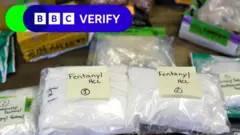 Seized fentanyl packages displayed by U.S. Customs and Border Protection, highlighting the influx of illicit fentanyl into the United States.
Seized fentanyl packages displayed by U.S. Customs and Border Protection, highlighting the influx of illicit fentanyl into the United States.
The escalating opioid crisis in the United States has brought the deadly drug fentanyl into sharp focus. With overdose deaths soaring, understanding where fentanyl comes from and how it enters the US is crucial to addressing this epidemic. For years, accusations have flown between nations, trade wars have ignited, and border security has tightened, all in an attempt to stem the flow of this potent synthetic opioid. But what are the real origins of fentanyl, and how does it make its way into American communities?
The Seriousness of the Fentanyl Crisis in the US
Fentanyl, initially developed for medical pain management, has morphed into a leading killer in the US drug crisis. The US Centers for Disease Control (CDC) reports that over 74,000 American lives were lost in 2023 due to drug overdoses involving fentanyl. This staggering number underscores the severity of the crisis. What makes fentanyl particularly dangerous is its potency; it’s significantly stronger than heroin, and even a minuscule amount – about the size of a few grains of salt – can be lethal.
Adding to the danger, fentanyl is often mixed with other illicit drugs like heroin, cocaine, and methamphetamine, frequently without the user’s knowledge. This unknowing consumption dramatically increases the risk of accidental overdose. The expanding global fentanyl supply chain over the last decade has further complicated efforts to control its spread, presenting immense challenges for law enforcement and policymakers alike.
Mexico: The Primary Entry Point for Fentanyl into the US
Despite initial focus on direct shipments from overseas, the overwhelming majority of fentanyl entering the United States now crosses the southwest border with Mexico. According to US Customs and Border Protection (CBP) data, a staggering 98% of seized fentanyl is intercepted at the US-Mexico border. This stark statistic highlights Mexico’s pivotal role in the fentanyl supply chain reaching the US. In stark contrast, less than 1% is seized at the northern border with Canada, and the small remainder comes through sea routes and other checkpoints.
The US Drug Enforcement Agency (DEA) has identified Mexican cartels, particularly the Sinaloa Cartel, as key players in the production and trafficking of fentanyl into the US. These cartels are not merely transit points; they are actively involved in manufacturing fentanyl within Mexico, utilizing precursor chemicals sourced largely from overseas. These chemicals are then synthesized into the final fentanyl product in clandestine labs located within Mexico.
To move these illicit substances across borders, cartels employ sophisticated concealment methods. This includes hiding chemicals within legitimate commercial goods, using deceptive labeling, operating through front companies, and routing shipments through third countries to obscure the true origin. The scale and ingenuity of these operations present a formidable challenge to border security and drug interdiction efforts.
China: The Dominant Source of Precursor Chemicals
While Mexico is the primary production and entry point for fentanyl, the journey of this drug often begins thousands of miles away in China. China remains the leading source of the precursor chemicals that are essential for fentanyl production. These are not the final fentanyl product itself, but the ingredients needed to synthesize fentanyl.
Although China classified fentanyl as a controlled narcotic in 2019 and subsequently added some precursor chemicals to its controlled substances list, loopholes persist. Many other chemicals used in fentanyl production remain unregulated, often because they have legitimate industrial uses. This legal ambiguity allows for continued trade in these chemicals, which are then diverted for illicit fentanyl manufacturing.
Investigations and US indictments have revealed a disturbing pattern: some Chinese chemical companies knowingly sell these precursor chemicals to individuals and entities involved in fentanyl production. Undercover operations have documented communications between agents and Chinese manufacturers, showing the explicit sale of chemicals intended for fentanyl synthesis. Furthermore, some manufacturers even provide instructions on how to convert these chemicals into fentanyl, facilitating the illegal production process. These transactions often occur through encrypted platforms and utilize cryptocurrency for payment, adding layers of complexity and anonymity.
Experts like Vanda Felbab-Brown from the Brookings Institute highlight the “massive loopholes” in the legal framework that allow criminals to exploit the trade in legal chemicals for illicit purposes. While China asserts it has stringent drug laws and has cooperated with the US in the past, the flow of precursor chemicals continues, indicating the ongoing challenge of controlling this aspect of the fentanyl supply chain. Adding to the complexity, India has also emerged as a significant source of these precursor chemicals, further diversifying the supply routes and origins.
Canada’s Role in the North American Fentanyl Trade
While the US-Mexico border is the primary focus, Canada’s role in the fentanyl trade within North America warrants examination. Despite President Trump’s accusations of Canada being a major conduit for fentanyl into the US, data from US Customs and Border Protection indicates that seizures at the Canadian border are minimal, accounting for only a fraction of the total fentanyl intercepted.
However, Canada is not entirely removed from the fentanyl equation. Canadian intelligence reports indicate a growing involvement of organized crime groups within Canada in fentanyl production. These groups are reportedly importing precursor chemicals and lab equipment from China to produce fentanyl domestically. This suggests a shift in dynamics, with Canada potentially becoming not just a transit country but also a production location to some extent.
Interestingly, the fentanyl trade operates in both directions across the US-Canada border. While more fentanyl is seized entering the US from Canada, there are also instances of fentanyl being seized entering Canada from the US. This bidirectional flow underscores the interconnected nature of the drug trade across North America. Canada has acknowledged the threat and pledged significant funding towards combating fentanyl and enhancing border security, indicating a commitment to addressing its role in the broader fentanyl crisis.
Conclusion: A Complex Web of Origins
Tracing the origins of fentanyl reveals a complex and multi-layered global supply chain. While the question “Where Does Fentanyl Come From?” might initially point to a single country, the reality is far more nuanced. The journey of fentanyl to the US involves a combination of factors:
- China as the primary source of precursor chemicals due to its vast chemical industry and regulatory loopholes.
- Mexico as the key production and transit hub, where cartels synthesize fentanyl and smuggle it across the US border.
- Evolving roles for countries like India and Canada, indicating a diversification of chemical sources and production locations.
Addressing the fentanyl crisis requires a multifaceted approach that goes beyond simply securing borders. It necessitates international cooperation to regulate precursor chemicals, dismantle transnational criminal organizations, and reduce demand for illicit opioids through prevention and treatment programs. Understanding the complex origins of fentanyl is the first crucial step in developing effective strategies to combat this devastating public health crisis.

